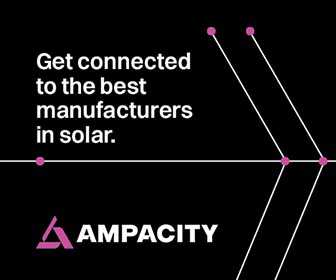Living the Dream of Net-Zero Energy & Storage
Millions of people and companies dream of never paying another electric bill. But for most, the possibility of actually going net-zero remains unattainable, either because they don’t think it’s affordable or even possible.
Among the crowd of dreamers was Mr. Wheelock, whose 1800 square-foot home was built in the 1980s. Poorly insulated, the house had sky-high air-conditioning costs and electric heating bills to match. Even in a dream, it was unlikely the house could attain anything close to a net-zero goal, where the total amount of energy used by the structure annually equals the amount of renewable energy created onsite.
Beliefs aside, Wheelock was nothing if not determined. After paying ongoing high utility costs, there is one thing of which he became certain: “I don’t want another electric bill—ever.”
The road to net zero
Not one to back down from a challenge, Wheelock’s quest began with a comprehensive energy analysis that revealed where power was going and where it was being wasted. This approach helped assess and reduce the house’s power electricity demands before any major energy changes or additional power sources were considered.
At first, older appliances were switched to Energy Star models, for example, and window awnings were added to block-out the summer heat. Eventually, Wheelock installed a solar water heater and solar attic vents, which have helped to keep the home cooler in the summer. The biggest gains, however, came from upgrading the home’s inefficient air-conditioning system.
Adding blown-in insulation boosted the attic’s R-value from R-19 to over R-50, reducing heat losses and stabilizing the indoor temperature. Next, daytime heating was installed to supplement the electric heating. Finally, a compressor-less air-conditioning alternative reduced Wheelock’s air-conditioning needs by nearly 90%. These systems slashed total electrical demand without sacrificing comfort.
Diurnal (nighttime) temperature swings are key to this system. During the summer, midday temperatures in the area hit 100° F (37.8° C). But they plummet to the 60s (far below 20° C) at night. These temperature swings are common in coastal and mountain areas from California up to Washington, as well as in Arizona, Nevada, Colorado, and New Mexico.
This simple ventilation/cooling system pressurizes the house to push in cool nighttime air and drive out hot air from the house. Because the house drops to the lowest outside temperature of the night, the building itself becomes a cooling system. During the daytime, the house stays cooler because the attic’s solar vents, insulation, and cold air from the night before prevent any heat buildup.
As a result, the system doesn’t have to cool incoming air with power-hungry compressors—it only brings in pre-cooled air—eliminating 90% of air-conditioning needs by using just 700 to 840 watts of power.
At this stage of the efficiency upgrades, Wheelock’s overall electric usage was down almost 50%. But, he wasn’t done. To reduce the amount of heating done by the house’s electric heat strips, daytime hot-air heating was also installed for the winter months. The system delivers enough warm air on sunny days to heat the whole home.
Moreover, the compressor-less cooler system is capable of reversing the direction of its airflow to also work during the colder months. Even on winter days, the air is often warmer during the day and colder at night. Although technically a cooling device, the system can pull in the warmer daytime air from the outside, warming the house to 70° F to 75° F (21° C to 24° C), and reducing nighttime heating needs.
The PV system gets its power from 36 mono-crystalline solar panels on three passive solar trackers. And, the grid-tied system sells back additional power.
After this first project, the Wheelock residence was net-zero for 2009, 2010, and 2011. But, after adding a welding studio to his home (he’s an artist who does metal scroll work in wrought iron), Wheelock was about to lose this status and have electric bills again, unless he generated more power.
Studio gains
With Wheelock’s decision to start welding at home, the home’s power needed a jump. Instead of throwing money at the challenge and simply adding more solar panels to his roof, Wheelock decided to install three ground-mounted, passive trackers. Though mostly passive, these trackers have the ability to “flip over” before the sun comes up to boost power output.
In addition, a thermal device ensures the trackers wake early, so the modules can catch the first sunlight in the morning. This device provides another 1,100 kilowatt-hours (kWh) per year, which is roughly a 10% gain. And, most importantly, that’s enough to bring the home back to its net-zero status.
By combining ground-mounted trackers with an early wakeup device, this system is over 54% more efficient than ground or roof-mounted panels. The panels generate an average of 40 kWh per day.
Power outages
What once were mere dreams had become a net-zero reality for Wheelock, until 2012. That year, utilities in San Diego began shutting off electricity to the backcountry during especially high winds, leaving thousands of people (including Wheelock) without power during windy weather.
Wheelock had power most of the time, but he never knew when his grid-connected power would be turned off. And without a backup system to store energy, solar system owners are dependent on daylight or the utility for their power. At times, these power outages can last days, and those affected can’t so much as pump water from their wells, never mind air-condition their homes or operate their businesses.
In 2014, Wheelock decided to become self-sufficient by installing a battery backup system to his home. Flooded, lead-acid batteries were chosen for their durability, cycle life, and ability to handle large temperature variations. In total, 16, six-volt, lead-acid batteries were used for Wheelock’s storage system. These batteries are rated at 390 AH (@20-hour rate), and are specifically designed for renewable applications, such as for use with solar power.
After installation, Wheelock received training on how to maintain the batteries in conjunction with the solar panels, for longer life and better performance. So far, Wheelock has been through three power outages, but he has yet to lose power in his home. Everything has continued to operate normally because of the battery backup system.
Wheelock’s home provides a shining example of energy efficiency, solar power, and storage, proving that net zero is a possibility without sacrificing modern comforts. And, despite running a welding studio, Mr. Wheelock has even beat his net-zero dream. Last year, he produced a $200 surplus of power.
Mark Snyder is the owner of Mark Snyder Electric, a renewable energy system installer and factory-certified inverter repair service for renewable energy and mobile systems.
Mark Snyder Electric
Author: Mark Snyder
Volume: March/April 2015










.png?r=8704)

